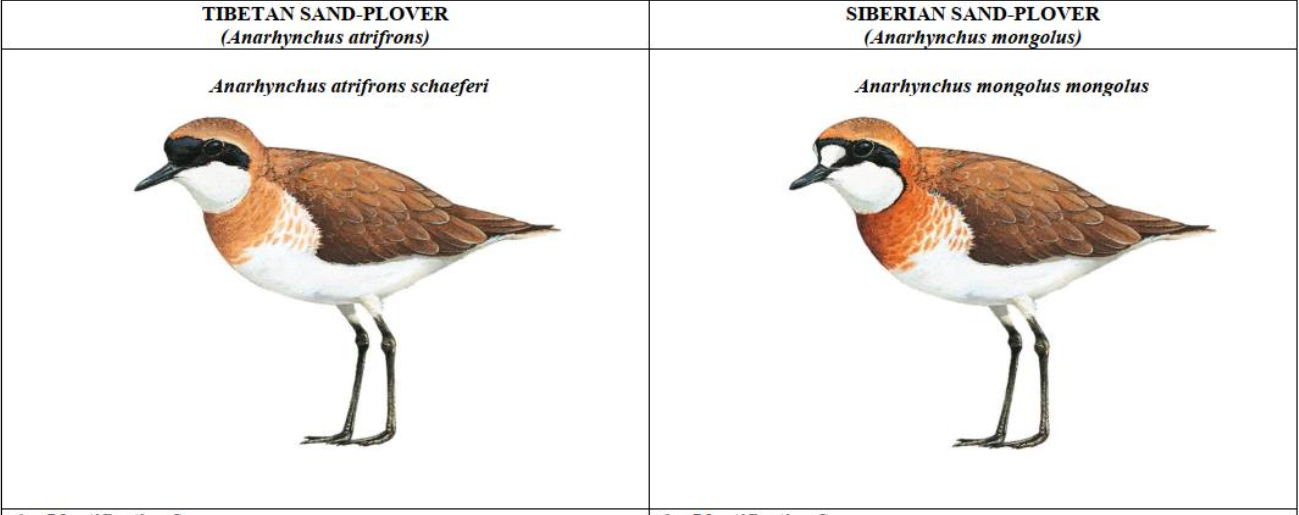Identification Differences within the Sand Plover Complex:
The sand plover group, which was traditionally divided into Greater Sand Plover (Charadrius leschenaultii) and Lesser Sand Plover (Charadrius mongolus), has shown some important differences through recent studies. These studies have made it clear that identifying these birds is more complicated than just looking at their appearance. In Vietnam wildlife, where you can spot these birds along beaches and wetlands, it’s easy to see why identifying them correctly can be tricky.
The Siberian Sand Plover (Anarhynchus mongolus) and Tibetan Sand Plover (Anarhynchus atrifrons) may look very similar, but they’re actually not closely related. This shows how important it is to look at more than just how the birds look, such as their behavior and genetic traits. Below are some simple tips to help you identify these two species when you’re out birdwatching in Vietnam.
1. Siberian Sand Plover (A. mongolus) vs. Tibetan Sand Plover (A. atrifrons):

Size and Structure:
- Siberian Sand Plover:
- Averages slightly larger with a deeper chest and bulkier appearance.
- Shorter bill with a more pronounced culmenary bulge near the tip, giving it a blunter appearance.
- Shorter tarsus and wings, which makes the toes barely project beyond the tail when in flight.
- Tibetan Sand Plover:
- Often looks slimmer and more proportionate.
- Longer bill, especially in the eastern subspecies (A. a. schaeferi) and (A. a. atrifrons), with a more pointed tip.
- Longer tarsus, longer wings, and a more obvious toe projection beyond the tail in flight, particularly in the western subspecies (A. a. pamirensis).
Plumage (Winter and Summer Differences):
- Siberian Sand Plover (Winter):
- Slightly darker ear-coverts than the crown and nape.
- A well-defined triangular white forehead patch bordered by darker feathers.
- Breast-band is usually complete or almost so, with some birds showing diagnostic dusky feathers along the flank.
- Tibetan Sand Plover (Winter):
- Ear-coverts concolorous with the crown and nape.
- The white on the forehead blends gradually into the brown forecrown without a clear border.
- Breast-band usually incomplete with white, unmarked flanks.
- Siberian Sand Plover (Summer):
- Generally darker brown upperparts.
- The brown on the central rump is broad with minimal white on the sides of the rump.
- Dusky underwing coverts and axillaries, often showing dusky markings.
- Tibetan Sand Plover (Summer):
- Paler and warmer brown upperparts.
- Narrower brown central rump with more white on the rump sides.
- White underwing coverts and axillaries.
In-flight Distinctions:
- Siberian Sand Plover:
- Longer-winged appearance, particularly noticeable during flight.
- Only four inner primaries show the white base of the wings, and the wing-bar is generally thinner.
- Tibetan Sand Plover:
- Wing-bar tends to be broader and the white on the primaries is more extensive than in Siberian Sand Plover.
- Toe projection beyond the tail in flight is more obvious, especially in the western subspecies.
2. Vocalization and Behavioral Differences:
- Siberian Sand Plover has distinct calls compared to both Tibetan Sand Plover and Greater Sand Plover, whose vocalizations are more similar. This highlights a key behavioral and ecological distinction between the species.
3. Phylogenetic Background and Genetic Distinction:
Recent genomic analysis (Wei et al. 2022) confirms that the traditional Lesser Sand Plover group is not monophyletic. Tibetan Sand Plover is more closely related to Greater Sand Plover, while Siberian Sand Plover forms a separate lineage. These findings challenge the previous assumptions based on morphological similarities and propose that Tibetan and Siberian Sand Plovers are not each other’s closest relatives.
Conclusion:
The sand plover group shows how birds that look alike can actually be quite different when you look closely. Siberian Sand Plover (A. mongolus) and Tibetan Sand Plover (A. atrifrons) have small but important differences in their size, feathers, and behavior, which means you need to pay attention to tell them apart.
If you’re interested in seeing these birds up close and learning more about Vietnam wildlife, WANEE offers you with birding and bird-watching tours to explore the country’s natural beauty and get insights from local experts to see more birds.
Read more about Vietnam birds!
How to Identify the Greater Sand Plover, Tibetan Sand Plover and Siberian Sand Plover
ContentsIdentification Differences within the Sand Plover Complex:1. Siberian Sand Plover (A. mongolus) vs. Tibetan Sand [...]
Cat Tien National Park Reptiles and Amphibian Endemic and Highlight
Cat Tien National Park is home to a remarkable diversity of reptiles and amphibians, including [...]
Cat Tien National Park Highlight Mammals
Explore Cat Tien National Park highlight mammals, from the elusive Black-shanked Douc Langur to the [...]
Kontum Plateau Endemic and Highlight bird
Kontum Plateau Endemic And Highlight Bird species like Chestnut-eared Laughingthrush and top birding routes while [...]
Dalat Plateau Endemic and highlight bird
The Dalat Plateau is a birdwatcher’s paradise, renowned for its exceptional biodiversity and unique highland [...]
Cat Tien National Park Endemic and highlight bird
Cat Tien National Park Endemic and highlight birds, like the Orange-necked Partridge and Germain’s Peacock [...]